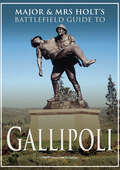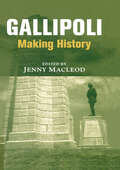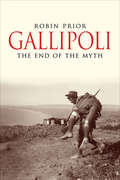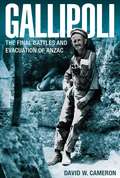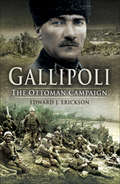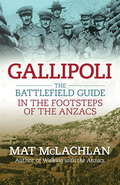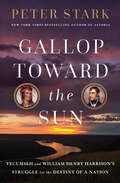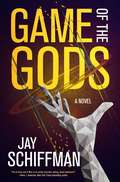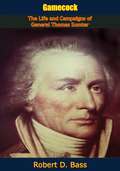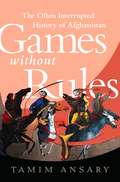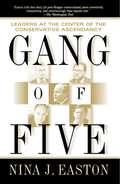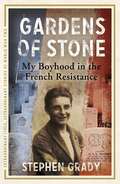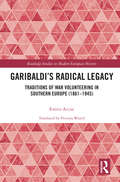- Table View
- List View
Gallipoli: An Australian Medical Perspective (Australian Combat Support #1)
by Michael TyquinTo be successful, a modern army needs logistical support to survive - to arm, feed, transport, and care for its soldiers. As history shows us the maintenance of health in any army , is a key factor in warfare. In many respects the Gallipoli campaign was a doomed undertaking. The seeds of ultimate defeat in December 1915 were the risks that attended a hugely ambitious, complex, and large-scale amphibious operation - the landings on well-defended shores on the Gallipoli peninsula, under cover of darkness. Communications at the time were primitive, while general staff officers had little understanding of their own army's medical assets or the needs of a large medical organisation. The Australian Army Medical Corps (AAMC) received aid from, and gave support to, all five forces at various times during 1915. Underlying the execution of the Dardanelles campaign were factors wholly outside the control of the Australian AMS. Undoubtedly tragic, and sometimes avoidable, errors were made at the highest level of command, with subsequent pressures on the AMS. An amphibious operation of this type and scale, however, was without parallel in modern military history, and mistakes were inevitable, as they are with any campaign of such complexity. Gallipoli: An Australian Medical Perspective explores these complexities and mistakes through the eyes of the infant Australian Army Medical Corps.
Gallipoli: Battlefield Guide (Major and Mrs Holt's Battlefield Guides)
by Tonie Holt Valamai HoltThis illustrated guide includes a historical overview of the battle, maps, itineraries, and updated information on memorials, museums, and more. The Battle of Gallipoli was one of the most bitterly fought conflicts of the Great War, and a profound and tragic loss for Entente powers of Britain, France, and Russia. This guidebook to the battlefields and historic sites of Gallipoli is an invaluable asset for any visitor who hopes to get the most out of their trip. Along with complete and updated information on museums, memorials, and war cemeteries, Major and Mrs. Holt provide essential historical overviews and practical itineraries covering all of the battleground sites. FULLY UPDATED
Gallipoli: Battlefield Guide (Major and Mrs Holt's Battlefield Guides)
by Tonie Holt Valamai HoltThis illustrated guide includes a historical overview of the battle, maps, itineraries, and updated information on memorials, museums, and more. The Battle of Gallipoli was one of the most bitterly fought conflicts of the Great War, and a profound and tragic loss for Entente powers of Britain, France, and Russia. This guidebook to the battlefields and historic sites of Gallipoli is an invaluable asset for any visitor who hopes to get the most out of their trip. Along with complete and updated information on museums, memorials, and war cemeteries, Major and Mrs. Holt provide essential historical overviews and practical itineraries covering all of the battleground sites. FULLY UPDATED
Gallipoli: Making History (Military History And Policy Ser.)
by Jenny MacleodThis new book traces the disparities in the memory of Gallipoli that are evident in the countries that participated in the campaign. It explores the way in which history is written at the personal, local, professional, and national levels.This study tackles key questions about just how the history of any given event comes to be written in a certain
Gallipoli: The End of the Myth
by Robin PriorThe noted historian&’s decisive and devastating history of the WWI Battle of Gallipoli &“sets a new standard for assessing the Allied Dardanelles campaign" (Mustafa Aksakal, American Historical Review). The Gallipoli campaign of 1915–16 was an ill-fated Allied attempt to take control of the Dardanelles, secure a sea route to Russia, and create a Balkan alliance against the Central Powers. A failure in all respects, the operation ended in disaster, and the Allied forces suffered some 390,000 casualties. In this conclusive study, military historian Robin Prior assesses the many myths about Gallipoli and provides definitive answers to questions that have lingered about the operation. Prior proceeds step by step through the campaign, dealing with naval, military, and political matters and surveying the operations of all the armies involved: British, Anzac, French, Indian, and Turkish. Relying on primary documents, including war diaries and technical military sources, Prior evaluates the strategy, the commanders, and the performance of soldiers on the ground. His conclusions are powerful and unsettling: the naval campaign was not &“almost&” won, and the land action was not bedeviled by &“minor misfortunes.&” Instead, the badly conceived Gallipoli campaign was doomed from the start. And even had it been successful, the operation would not have shortened the war by a single day. Despite their bravery, the Allied troops who fell at Gallipoli died in vain.A Wall Street Journal Best Book of 2009
Gallipoli: The Final Battles and Evacuation of ANZAC (Big Sky Publishing Ser.)
by David W. CameronIn early August with the failure of the August Offensive at Gallipoli the senior commanders still believed that victory was possible. To help prepare for a new offensive sometime in the first half on 1916 the allied forces attempted to straighten out the line connecting Suvla and Anzac at a small hillock called Hill 60.
Gallipoli: The Ottoman Campaign
by Edward J. EricksonGallipoli tells of the disastrous campaign at Gallipoli in 1915 when the allies failed to knock Turkey out of the war. With then and now photographs the book provides detailed historical descriptions of the area and the events, all of which will appeal to the armchair historian and the intrepid visitor to the sites. It will prove an indispensable companion.
Gallipoli: The Ottoman Campaign (Battleground Europe)
by Nigel SteelGallipoli tells of the disastrous campaign at Gallipoli in 1915 when the allies failed to knock Turkey out of the war. With then and now photographs the book provides detailed historical descriptions of the area and the events, all of which will appeal to the armchair historian and the intrepid visitor to the sites. It will prove an indispensable companion.
Gallipoli: The battlefield guide
by Mat MclachlanThe essential travel companion for anyone visiting Gallipoli.Each year, thousands of Australians visit Gallipoli to pay homage and see where their forebears fought, suffered and died. Anzac Cove, Quinn's Post, Lone Pine - the iconic places where our national legend was forged.In this essential and authoritative guide, practical information is combined with historical detail, alongside revealing and often heartrending quotes from the letters and diaries of the Anzacs themselves.- Detailed easy-to-follow plans for walking and driving tours across the main battlefields- Maps, photos and historical commentary to put the campaign in context- Everything you need to know where to go, where to stay and how to get there.Walk where the Anzacs walked, see where they fought and marvel at their courage.
Gallop Toward the Sun: Tecumseh and William Henry Harrison's Struggle for the Destiny of a Nation
by Peter StarkA vivid account of the rivalry between future president William Henry Harrison and the Shawnee chief Tecumseh—and of the Native American alliance that fought westward expansion—from the New York Times bestselling author of Astoria&“Taut, multi-layered . . . a much-needed reevaluation of this crucial period of our nation&’s history.&”—Laurence Bergreen, author of Over the Edge of the WorldThe conquest of Indigenous land in the eastern United States through corrupt treaties and genocidal violence laid the groundwork for the conquest of the American West. In Gallop Toward the Sun, acclaimed author Peter Stark exposes the fundamental conflicts at play through the little-known but consequential struggle between two extraordinary leaders.William Henry Harrison was born to a prominent Virginia family, the son of a signer of the Declaration of Independence. He journeyed west, became governor of the vast Indiana Territory, and sought statehood by attracting settlers and imposing one-sided treaties.Tecumseh, by all accounts one of the nineteenth century&’s greatest leaders, belonged to an honored line of Shawnee warriors and chiefs. His father, killed while fighting the Virginians flooding into Kentucky, extracted a promise from his sons to &“never give in&” to the land-hungry Americans. An eloquent speaker, Tecumseh traveled from Minnesota to Florida and west to the Great Plains convincing far-flung tribes to join a great confederacy and face down their common enemy. Eager to stop U.S. expansion, the British backed Tecumseh&’s confederacy in a series of battles during the forgotten western front of the War of 1812 that would determine control over the North American continent.Tecumseh&’s brave stand was likely the last chance to protect Indigenous people from U.S. expansion—and prevent the upstart United States from becoming a world power. In this fast-paced narrative—with its sharply drawn characters, high-stakes diplomacy, and bloody battles—Peter Stark brings this pivotal moment to life.
Galloping at Everything
by Ian FletcherThe poor discipline demonstrated by the British cavalry commanded by general Slade at Maguilla in 1812 prompted the Duke of Wellington's famous remark that British cavalry officers were in the habit of galloping at everything. This work rehabilitates the reputation of the British cavalry in the Peninsula and at Waterloo.
Gambit
by Karna Small BodmanKarna Small Bodman's first thriller, Checkmate, was praised for its compelling authenticity and page-turning plot. Now Bodman, a former director of the National Security Council, returns with another gripping thriller that reads like tomorrow's headlines. American planes are being shot out of the sky, and no one knows how or why. Three commercial jets have gone up in flames. In each crash, nobody reported seeing anything in the sky and nothing showed up on the radar. No planes. No missiles. Dr. Cameron Talbot, a world-famous expert on missile-defense systems, believes that a new stealth technology is being used in these attacks. With the country in a panic and the economy taking a nosedive, the White House orders the beautiful young scientist to protect America's endangered airways. The assignment places Cammy in mortal jeopardy as she finds herself stalked by nameless assassins. Who is behind the threat? Islamic jihadists? The big drug cartels? None of the usual suspects have claimed responsibility for the crashes. As Cammy races against time to develop a defense against the mystery weapon, she comes to suspect that the downed planes are only the opening gambit in an ambitious campaign of conquest that could change the world's balance of power forever.
Gambling with Armageddon: Nuclear Roulette from Hiroshima to the Cuban Missile Crisis
by Martin J. SherwinFrom the Pulitzer Prize-winning author of American Prometheus: The Triumph and Tragedy of J. Robert Oppenheimer comes the first effort to set the Cuban Missile Crisis, with its potential for nuclear holocaust, in a wider historical narrative of the Cold War--how such a crisis arose, and why at the very last possible moment it didn't happen.In this groundbreaking look at the Cuban Missile Crisis, Martin Sherwin not only gives us a riveting sometimes hour-by-hour explanation of the crisis itself, but also explores the origins, scope, and consequences of the evolving place of nuclear weapons in the post-World War II world. Mining new sources and materials, and going far beyond the scope of earlier works on this critical face-off between the United States and the Soviet Union--triggered when Khrushchev began installing missiles in Cuba at Castro's behest--Sherwin shows how this volatile event was an integral part of the wider Cold War and was a consequence of nuclear arms. Gambling with Armageddon looks in particular at the original debate in the Truman Administration about using the Atomic Bomb; the way in which President Eisenhower relied on the threat of massive retaliation to project U.S. power in the early Cold War era; and how President Kennedy, though unprepared to deal with the Bay of Pigs debacle, came of age during the Cuban Missile Crisis. Here too is a clarifying picture of what was going on in Khrushchev's Soviet Union. Martin Sherwin has spent his career in the study of nuclear weapons and how they have shaped our world. Gambling with Armegeddon is an outstanding capstone to his work thus far.
Game of the Gods: A Novel
by Jay Schiffman"The dystopian novel is alive and well in the blisteringly effective Game of the Gods. Jay Schiffman breathes life into a moribund genre and ends up crafting a sly, shrewd and stunning take on a darkly depraved future that is every bit the equal of The Hunger Games, The Maze Runner, and the Divergent series. Schiffman's striking vision serves up a cloud-riddled tomorrow featuring just enough silver linings to provide hope to an otherwise bleak landscape. A must read for fans of classics like Judge Dredd and Doc Savage." --Jon Land, USA Today bestselling author of the Caitlin Strong seriesJay Schiffman's Game of the Gods is a debut sci-fi/fantasy thriller of political intrigue and Speilberg-worthy action sequences in the vein of Pierce Brown's Red Rising.Max Cone wants to be an ordinary citizen of the Federacy and leave war and politics behind. He wants the leaders of the world to leave him alone. But he’s too good a military commander, and too powerful a judge, to be left alone. War breaks out, and Max becomes the ultimate prize for the nation that can convince him to fight again. When one leader gives the Judge a powerful device that predicts the future, the Judge doesn’t want to believe its chilling prophecy: The world will soon end, and he’s to blame. But bad things start to happen. His wife and children are taken. His friends are falsely imprisoned. His closest allies are killed. Worst of all, the world descends into a cataclysmic global war.In order to find his family, free his friends, and save the world, the Judge must become a lethal killer willing to destroy anyone who stands in his way. He leads a ragtag band of warriors—a 13-year old girl with special powers, a mathematical genius, a religious zealot blinded by faith, and a former revolutionary turned drug addict. Together, they are the only hope of saving the world.At the Publisher's request, this title is being sold without Digital Rights Management Software (DRM) applied.
Game to the Last: 11th Australian Infantry Battalion at Gallipoli (The\australian Army History Ser.)
by James HurstGame to the Last reveals the story of the men who would become "one of the finest battalions which served in the war", the West Australian 11th Infantry Battalion, AIF, during the gruelling Gallipoli Campaign of 1915. The narrative follows the battalion members as they leave their homes and lives in Western Australia, embark for overseas, experience the excitement and boredom of arid and exotic Egypt, and undergo their baptism of fire in the first wave of the Australian and New Zealand landings at Gallipoli on 25 April 1915.
Gamecock: The Life and Campaigns of General Thomas Sumter
by Robert D. BassThis is a 1961 biography by distinguished historian and author, Dr. Robert D. Bass, of the elusive American general Thomas Sumter—nicknamed the “Carolina Gamecock,” for his fierce fighting style—and his campaigns against the British Army in the South during the American Revolution.Thomas Sumter (August 14, 1734 - June 1, 1832) was a soldier in the Colony of Virginia militia, a brigadier general in the South Carolina militia during the American War of Independence, a planter, and a politician. After the United States gained independence, he was elected to the United States House of Representatives and to the United States Senate, where he served from 1801-1810, when he retired.
Games without Rules: The Often-Interrupted History of Afghanistan
by Tamim AnsaryToday, most Westerners still see the war in Afghanistan as a contest between democracy and Islamist fanaticism. That war is real; but it sits atop an older struggle, between Kabul and the countryside, between order and chaos, between a modernist impulse to join the world and the pull of an older Afghanistan: a tribal universe of village republics permeated by Islam.<P><P> Now, Tamim Ansary draws on his Afghan background, Muslim roots, and Western and Afghan sources to explain history from the inside out, and to illuminate the long, internal struggle that the outside world has never fully understood. It is the story of a nation struggling to take form, a nation undermined by its own demons while, every 40 to 60 years, a great power crashes in and disrupts whatever progress has been made. Told in conversational, storytelling style, and focusing on key events and personalities, Games without Rules provides revelatory insight into a country at the center of political debate.
Gang of Five: Leaders at the Center of the Conservative Crusade
by Nina J. EastonIn Gang of Five, bestselling author Nina J. Easton adds an important element to the history of American politics in the last thirty years. This is the story of the other, less well known segment of the baby-boom generation. These are young conservative activists who arrived on campus in the 1970s in rebellion against everything "sixties" and went on to overturn the political dynamics of the country in the 1980s and 1990s. They've been waging what Newt Gingrich called a "war without blood" for three decades. Gang of Five portrays the intertwining careers of five major figures: BILL KRISTOL, the Harvard-educated elitist and publisher of the Weekly Standard, is the liberal establishment's worst nightmare -- a witty, erudite Rightist who was a leading force behind the demise of the Clinton health care plan, the historic reform of welfare, and the decision of House Republicans to impeach the president. RALPH REED, the hardball politico who helped turn an organization called the College Republicans into a kind of communist cell of the Right, in the 1990s tried to give the Religious Right a softer face as leader of the Christian Coalition but was thwarted by his thirst for power and the narrow fundamentalism of his activist followers. CLINT BOLICK, a leading force in the spread of school choice programs and the anti-affirmative action strategist who sank Lani Guinier's appointment, is the idealist who seeks to convince civil rights leaders that his legal work on behalf of disadvantaged minorities is sincere and that liberal programs hurt the people they are meant to help. GROVER NORQUIST, the "market Leninist" who divides the world into "good" and "evil," is at the hub of Hillary Clinton's "vast right-wing conspiracy" and is the architect of a no-new-taxes pledge signed by all major Republican candidates in the 1990s. DAVID MCINTOSH, the policy wonk who took the movement's war on Washington to Congress as leader of the House Republican freshmen during the Gingrich Revolution, pushed his party toward confrontation with the White House and is now running for governor in Indiana. In contrast to earlier generations of conservatives, these leaders and their allies tasted success, first with Ronald Reagan's twin victories in the 1980s and then, in the 1990s, with the Republican capture of Congress. They play to win and have had a hand in every major insurrection from the Right over the past two decades -- from abortion politics to government shutdowns to political muckracking. No politician can ignore their agenda or escape the new hardball rules they've written for national politics.
Gangs, Pseudo-Militaries, and Other Modern Mercenaries: New Dynamics in Uncomfortable Wars (International and Security Affairs Series #6)
by Max G. Manwaring Edwin G. Corr John T. Fishel<p>As the first decade of the twenty-first century has made brutally clear, the very definitions of war and the enemy have changed almost beyond recognition. Threats to security are now as likely to come from armed propagandists, popular militias, or mercenary organizations as they are from conventional armies backed by nation-states. In this timely book, national security expert Max G. Manwaring explores a little-understood actor on the stage of irregular warfare—the gang. <p>Since the end of the Cold War, some one hundred insurgencies or irregular wars have erupted throughout the world. Gangs have figured prominently in more than half of those conflicts, yet these and other nonstate actors have received little focused attention from scholars or analysts. This book fills that void. <p>Employing a case study approach, and believing that shadows from the past often portend the future, Manwaring begins with a careful consideration of the writings of V. I. Lenin. He then scrutinizes the Piqueteros in Argentina, gangs in Colombia, private armies in Mexico, Hugo Chavez's use of popular militias in Venezuela, and the looming threat of Al Qaeda in Western Europe. <p>As conventional warfare is increasingly eclipsed by these irregular and “uncomfortable” wars, Manwaring boldly diagnoses the problem and recommends solutions that policymakers should heed.</p>
Garden of Ruins: Occupied Louisiana in the Civil War (Conflicting Worlds: New Dimensions of the American Civil War)
by J. Matthew WardJ. Matthew Ward’s Garden of Ruins serves as an insightful social and military history of Civil War–era Louisiana. Partially occupied by Union forces starting in the spring of 1862, the Confederate state experienced the initial attempts of the U.S. Army to create a comprehensive occupation structure through military actions, social regulations, the destabilization of slavery, and the formation of a complex bureaucracy. Skirmishes between Union soldiers and white civilians supportive of the Confederate cause multiplied throughout this period, eventually turning occupation into a war on local households and culture. In unoccupied regions of the state, Confederate forces and their noncombatant allies likewise sought to patrol allegiance, leading to widespread conflict with those they deemed disloyal. Ward suggests that social stability during wartime, and ultimately victory itself, emerged from the capacity of military officials to secure their territory, governing powers, and nonmilitary populations. Garden of Ruins reveals the Civil War, state-building efforts, and democracy itself as contingent processes through which Louisianans shaped the world around them. It also illustrates how military forces and civilians discovered unique ways to wield and hold power during and immediately after the conflict.
Gardens of Stone: My Boyhood In The French Resistance (Extraordinary Lives, Extraordinary Stories of World War Two #6)
by Michael Wright Stephen GradyAn extraordinary wartime memoir, combining the best kind of adventure story with a coming of age testimony of unforgettable resonance and poignancy. September 2011, Halkidiki, Northern Greece. A solitary 86 year-old man gazes across an Aegean headland, knowing that he must finally confront his past. He begins to write... September 1939, Nieppe, Northern France. 14 year-old Stephen is living with his family, 25 kilometres from Ypres. His French mother battles with her encroaching blindness. Failing to escape the advancing German army, his English father can no longer look after the war graves that cast so heartbreaking a shadow across the region. Stephen and his friend Marcel embark upon their great adventure: collecting souvenirs from strafed convoys and crashed Messerschmitts. But their world turns dark when arrested and imprisoned for sabotage and threatened with deportation or the firing squad. Upon his release, and still only 16, Stephen is recruited by the French Resistance. Growing up under the threat of imminent betrayal, he learns the arts of clandestine warfare, and - in a moment that haunts him still - how to kill... Such was the impact of Stephen Grady's work for the French Resistance, (especially during the countdown to D-Day and its bloody aftermath) that he was awarded the Croix de Guerre and the American Medal of Freedom.
Gardens of Stone: My Boyhood in the French Resistance
by Michael Wright Stephen GradyAn extraordinary wartime memoir, combining the best kind of adventure story with a coming of age testimony of unforgettable resonance and poignancy. September 2011, Halkidiki, Northern Greece. A solitary 86 year-old man gazes across an Aegean headland, knowing that he must finally confront his past. He begins to write... September 1939, Nieppe, Northern France. 14 year-old Stephen is living with his family, 25 kilometres from Ypres. His French mother battles with her encroaching blindness. Failing to escape the advancing German army, his English father can no longer look after the war graves that cast so heartbreaking a shadow across the region. Stephen and his friend Marcel embark upon their great adventure: collecting souvenirs from strafed convoys and crashed Messerschmitts. But their world turns dark when arrested and imprisoned for sabotage and threatened with deportation or the firing squad. Upon his release, and still only 16, Stephen is recruited by the French Resistance. Growing up under the threat of imminent betrayal, he learns the arts of clandestine warfare, and - in a moment that haunts him still - how to kill... Such was the impact of Stephen Grady's work for the French Resistance, (especially during the countdown to D-Day and its bloody aftermath) that he was awarded the Croix de Guerre and the American Medal of Freedom.
Gardens of Stone: My Boyhood in the French Resistance (Extraordinary Lives, Extraordinary Stories of World War Two #6)
by Michael Wright Stephen GradyAn extraordinary wartime memoir, combining the best kind of adventure story with a coming of age testimony of unforgettable resonance and poignancy.September 2011, Halkidiki, Northern Greece. A solitary 86 year-old man gazes across an Aegean headland, knowing that he must finally confront his past. He begins to write...September 1939, Nieppe, Northern France. 14 year-old Stephen is living with his family, 25 kilometres from Ypres. His French mother battles with her encroaching blindness. Failing to escape the advancing German army, his English father can no longer look after the war graves that cast so heartbreaking a shadow across the region. Stephen and his friend Marcel embark upon their great adventure: collecting souvenirs from strafed convoys and crashed Messerschmitts. But their world turns dark when arrested and imprisoned for sabotage and threatened with deportation or the firing squad. Upon his release, and still only 16, Stephen is recruited by the French Resistance. Growing up under the threat of imminent betrayal, he learns the arts of clandestine warfare, and - in a moment that haunts him still - how to kill... Such was the impact of Stephen Grady's work for the French Resistance, (especially during the countdown to D-Day and its bloody aftermath) that he was awarded the Croix de Guerre and the American Medal of Freedom.(P)2013 Hodder & Stoughton
Garibaldi
by Peter Dennis Ron FieldThis book looks closely at the life, military experiences and key battlefield exploits of Giuseppe Garibaldi. Born on July 4, 1807 in the city of Nice, the turning point in his life occurred in April 1833 when he met Giovanni Battista Cuneo, a member of the secret movement known as "Young Italy." Joining this society, Garibaldi took an oath dedicating his life to the struggle for the liberation of his homeland from Austrian dominance. The subsequent years would see him fighting in Brazil, in the Uruguayan Civil War, and on the Italian peninsula. Between 1848 and 1870, Garibaldi and his men were involved in a prolonged struggle that eventually led to the final unification of Italy in 1870.
Garibaldi’s Radical Legacy: Traditions of War Volunteering in Southern Europe (1861–1945) (Routledge Studies in Modern European History #84)
by Enrico AcciaiBetween the two world wars, thousands of European antifascists were pushed to act by the political circumstances of the time. In that context, the Spanish Civil War and the armed resistances during the Second World War involved particularly large numbers of transnational fighters. The need to fight fascism wherever it presented itself was undoubtedly the main motivation behind these fighters’ decision to mobilise. Despite all this, however, not enough attention has been paid to the fact that some of these volunteers felt they were the last exponents of a tradition of armed volunteering which, in their case, originated in the nineteenth century. The capacity of war volunteering to endure and persist over time has rarely been investigated in historiography. The aim of this book is to reconstruct the radical and transnational tradition of war volunteering connected to Giuseppe Garibaldi’s legacy in Southern Europe between the unification of Italy (1861) and the end of the Second World War (1945). This book seeks to provide a comprehensive analysis of the long-term, interconnected, and radical dimensions of the so called Garibaldinism.


